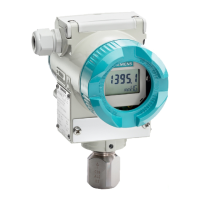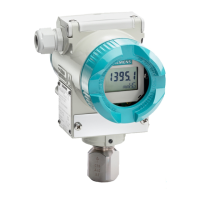SITRANS P300 (7MF8.23.. 7MF8.24.. 7MF8.25..)
A5E03434759-01, 08/2011
79
③
Procesa noslēgvārsts
⑦
Noslēgvārsts (papildaprīkojums)
⑧
Kondensāta trauks (papildaprīkojums)
④
Noslēgvārsts pārbaudes pieslēgumam vai
atgaisošanas skrūvei
⑨
Izplūdes vārsts
Priekšnosacījums
Visi vārsti ir aizvērti.
Kā jārīkojas
Lai uzsāktu mērījumu pārveidotāja ekspluatāciju, strādājot ar gāzēm, rīkojieties šādi:
1. Atveriet pārbaudes pieslēguma noslēgvārstu
④.
2. Pa noslēgvārsta armatūras
② pārbaudes pieslēgumu padodiet uz mērpārveidotāju ① spiedienu, kas atbilst mērīšanas
diapazonam.
3. Pārbaudiet mērījumu sākumu.
4. Ja mērījumu sākums neatbilst vajadzīgajai vērtībai, koriģējiet to.
5. Aizveriet pārbaudes pieslēguma noslēgvārstu ④.
6. Atveriet noslēgvārstu
⑥ pie spiediena noņemšanas vietas.
7. Atveriet procesa noslēgvārstu
③.
Uzturēšana un apkope
Svarīgākie drošības norādījumi
BRĪDINĀJUMS
Neatļauts remonts ierīcēm ar sprādzienaizsardzību
Eksplozijas bīstamība sprādzienbīstamās vietās.
● Remontu drīkst veikt tikai Siemens pilnvarots pārstāvis.
BRĪDINĀJUMS
Neatļauti piederumi un rezerves daļas
Eksplozijas bīstamība sprādzienbīstamās vietās.
● Izmantojiet tikai oriģinālās rezerves daļas.
● Ievērojiet visas atbilstošās uzstādīšanas un drošības instrukcijas, kas aprakstītas ierīces rokasgrāmatā vai pievienotas
piederumam vai rezerves daļai.
BRĪDINĀJUMS
Apkope nepārtrauktas darbības laikā bīstamās vietās
Pastāv bīstamība, veicot remonta un apkopes darbus ierīcei bīstamā zonā.
● Atvienojiet ierīci no barošanas.
- vai -
● Nodrošiniet, lai vide ir sprādziendrosā (atļauja veikt ugunsbīstamus darbus).

